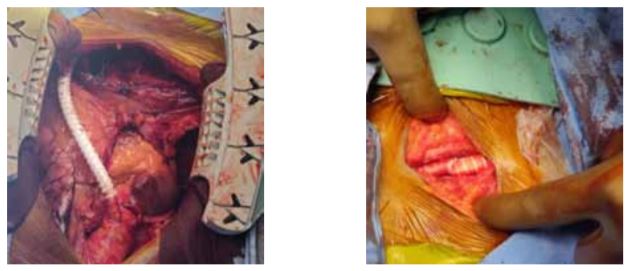Unconventional Case of CABG with Ascending Aorta to Common Femoral Bypass Grafting
62 Years male, chronic smoker presented with progressively severe pain in left calf and foot at rest, with a non-healing ulcer at the great toe for 6 months. The pain is so severe that he is not able to do his routine daily activity. Along with that, he had retrosternal pain radiating to hands. CT peripheral aortography suggests total occlusion of left common iliac with reformation at the level of common femoral, again 100% occlusion of popliteal and posterior tibial with the full reformation of the anterior tibial artery. Coronary angiogram suggests Severe TVD. After evaluation, he underwent Off-pump CABG LIMA to LAD, with RA to RCA with Ascending aorta Left common femoral bypass grafting using 8 F ribbed Goretex graft. Since preoperatively patient was suffering from incredible leg pain and discomfort, the plan was to do limb revascularization in the same sitting. For this after sternotomy first ascending aorta was evaluated for any plaques. Then Left femoral artery was explored and secured. After this tunnelling was done extraperitoneal and under the inguinal ligament. The long piece of gauge was passed through both incisions.
Then LIMA and The left Radial artery was harvested and grafting was performed in a routine manner. After CABG. 8F ribbed graft was passed and proximal and distal anastomosis with ascending aorta and left common femoral artery was performed using partial clamps with 5/0 prolene sutures. Heparin was reversed and incisions were closed in the usual manner. In the postoperative period, the leg the pain was reduced and the patient was discharged uneventfully.
CORONARY ARTERY DISEASE WITH Peripheral Arterial disease is a very well known entity. Majority of times CABG is performed earlier and separately because of long operative hours and dissection induced bleedings. Surgery for PVD needs separate attention and normally performed 4 to 6 weeks later of CABG. Unconventionally, in this case, we selected ascending aorta for proximal anastomosis as the patient was extremely symptomatic and abdominal aorta was apparently mildly calcified on CT AORTOGRAM. Ascending aorta is disease-free in most of the cases and long term results are better and comparable with bypass grafting with another part of the aorta. Selecting this also reduces the time of operating hours with long term patency of the graft.
Dr .Vijay Dikshit
M.B.B.S; M.S.(Surgery); M.Ch.(Thoracic Surgery),
Sr Consultant Cardio-Thoracic Surgeon,
Apollo Hospitals, Jubilee Hills, Hyderabad, India.
Dr. Sanjeev Kumar Khulbey
MBBS; MS (General Surgery); MCh,
Sr Consultant Cardio Thoracic & Vascular Surgeon,
Apollo Hospitals, Jubilee Hills, Hyderabad, India.
Dr. Sanjay Kumar Agarwal
MBBS; MS (GENERAL SURGERY); MCh. (CTVS),
Sr Consultant Cardio Thoracic & Vascular Surgeon,
Apollo Hospitals, Jubilee Hills, Hyderabad, India.
Dr. Badri Narayana Tumulu
MBBS; MD (Medicine), DM (Cardiology),
Sr Consultant Cardiologist,
Apollo Hospitals, Jubilee Hills, Hyderabad, India.
Dr.Anand Kumar Sathapathy
Anaesthetist,
Apollo Hospitals, Jubilee Hills, Hyderabad, India.
Dr. U. Srinivas
Anaesthetist,
Apollo Hospitals, Jubilee Hills, Hyderabad, India.



